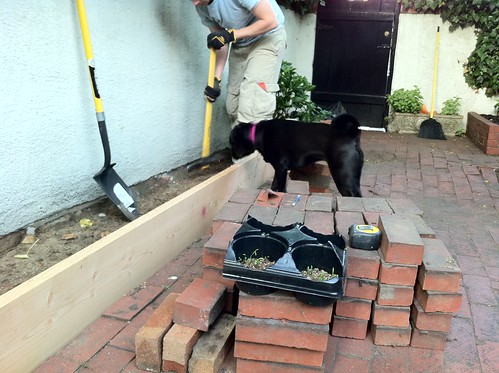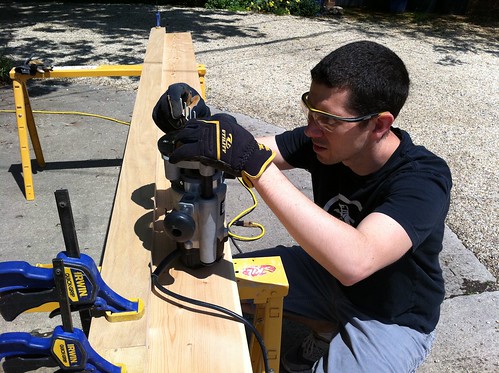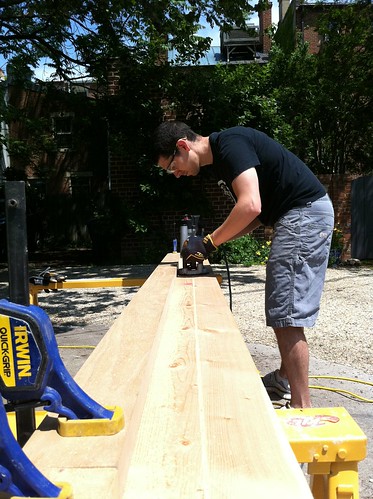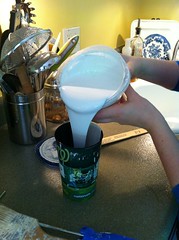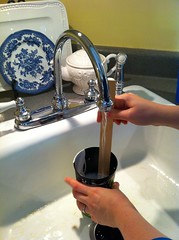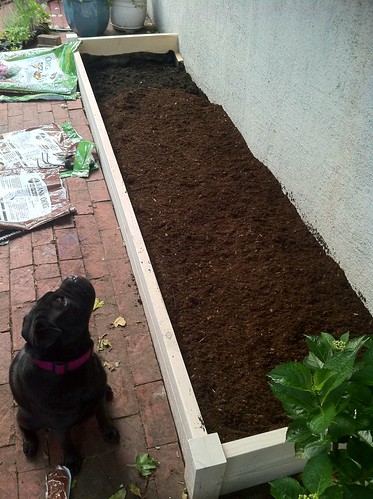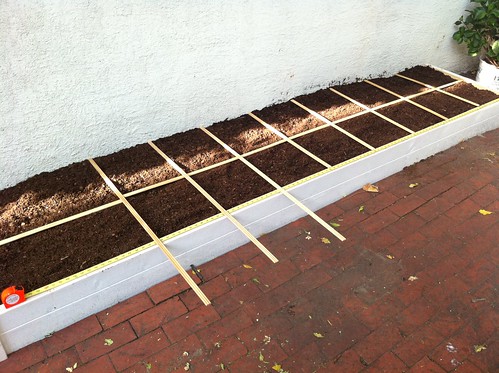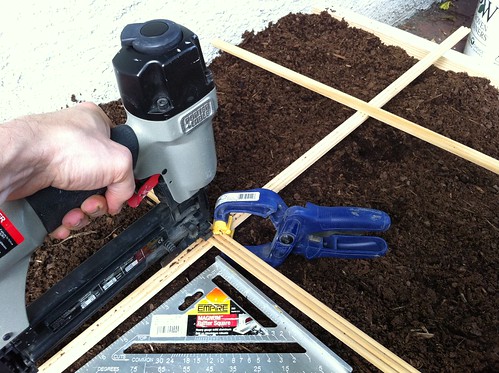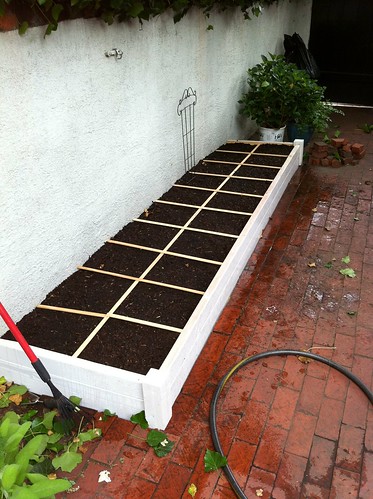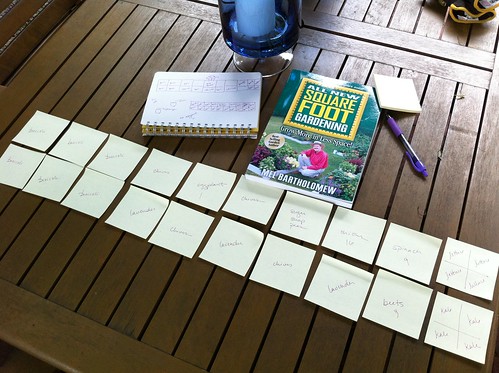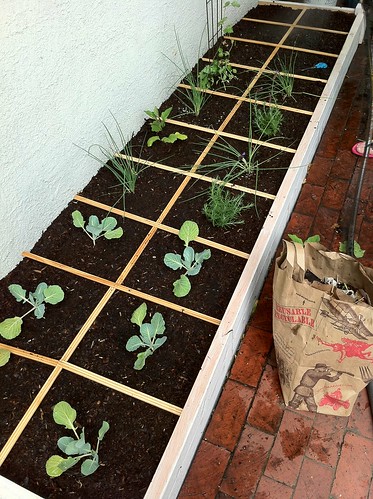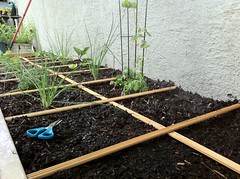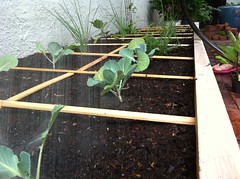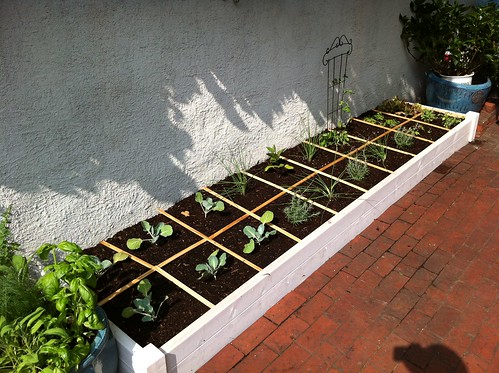We selected the north wall in our backyard to ensure it receives as much sunlight as possible. The amount of light we get is going to be the big limiting factor in our garden. With our large tree at one end of the yard, and the house at the other, we get just a few hours of sunlight per day. This spot gives us our best chance at success.
With the location chosen, we pulled up all of the bricks and cleared the area of debris and stubborn obstructions.
Once cleared, we felt good about our decision to go with the square foot garden method of planting. The space we selected is roughly 10'x2', which will give us 20 1'x1' areas to plant. The book outlines a 4'x4' square area as ideal, primarily because you can comfortably reach into the middle of your garden by about two feet from any side without losing your balance and falling in. Since our garden is against a wall, two feet deep is perfect.
After much research, we planned on building the box to be 9" deep (but it will appear only 7" deep when you consider the depth of the bricks). You can see the reveal of the border in the photo above. This depth will allow us about 7"-8" of soil to plant in without needing to overfill the bed.
With everything planned out, we got started on the box construction. We're using standard 2x10 material for the border, but we don't really want it to look like we just stuck a couple of 2x10s on the ground. In order to provide a little decoration, we placed two small posts at the corners of the box. We also decided to make it appear as if the borders were several pieces of stacked wood.
To accomplish this look, we figured we could use our router to cut a V-groove. After getting everything setup in the back parking area, we set the depth of cut on the router to 1/4".
Once the router was set, I clamped a few boards to the top to use as a guide and got started cutting.
After all three border boards received their grooves, I sanded them with 120 grit sandpaper to get all of the ink and marks off of the boards, and also to smooth out the grooves that I had cut (soft wood usually "fuzzes" up when you cut it with the router). Then Wendy started to work on painting the exterior of the boards.
Wendy wanted to give the border a white washed look rather than a heavy painted finish. To accomplish this, she mixed a formula of equal parts white latex paint and water.
The slightly watered down paint let the grain of the wood faintly show through, so it looks just a little bit more natural. And to ensure paint residue is not leaching onto our veggies, she only painted the exterior and top of the boards and posts.
After the paint dried (it took about 10 minutes on this particularly beautiful and sunny day), we placed the posts and border and screwed the corners together using a few exterior grade decking screws.
The bed was just about ready for soil, we were finally making some progress. The ground below the bed is thick with tree and ivy roots, so we opted to lay a fabric weed stop mat on the bottom of the bed before we placed any soil. Hopefully this step will keep the roots at bay and away from choking out our veggies. Worst case, we can remove the dirt next summer to clear the roots and implement a more permanent solution. What that may be...I have no idea.
As you can see from the photo, I had quite a bit of help placing the fabric. Every time it wasn't quite right, Lulu would make sure I didn't leave well enough alone and would run through the blocker and mess it up completely. It was very, um, helpful. Once I had the weed block in place, it was time to start dumping the soil.
Again...lots of help. We ended up using bags of "Organic Choice" soil rather than mixing up our own. We did a bit of research and determined that this soil mixture was comprised of the essential items that were outlined in "Mel's Mixture" form our book and also of the items that were outlined through the various pieces of advice we've received along the way.
With the soil in place, the final step to building our square foot vegetable garden was our square foot grid. The grid is an important part of the garden as it defines how many items you plant and where you plant them. Our next post will go into much greater depth on this aspect of the garden, but for now, I'm just building.
You can use a lot of different things to make the grid. From twine, to wire to a pre-made grid. But as luck would have it, I'm a borderline wood hoarder (you should see our disaster of a basement) so we had some leftover molding from a previous project that I was able to dig up for use as our grid. Whenever this sort of thing happens we feel great. Wendy loves it because we save a few dollars by reusing something most would have thrown away. I love it because it gives justification and purpose to my inability to throw away wood that "I might eventually have a use for." To each their own, right?
To lay out the border, we cut the wood to make 20 one square foot boxes. These are rough square feet because the border isn't quite a consistent depth. The bricks are not parallel with the wall so we opted to follow the line of the bricks so your attention wouldn't be drawn to how out of square everything is. This complicated the grid a little, but it just meant we would need to cut each individual cross piece a little different size.
After all of the pieces were cut, we just needed to nail it all together. I used my super awesome pancake compressor and brad nailer with 5/8" nails at each cross point. I also used a carpenter's square to ensure the box was actually a box and not a triangle, and a small pressure clamp to keep the grid where it needed to stay while I nailed each section.
The end result was pretty nice. It may not be the single most aesthetically pleasing item in our backyard, but we're hoping that it's a fair trade off for the enjoyment we'll get from eating our first item from the garden.
So there you have it, our vegetable garden bed has been constructed, filled with soil, and fitted with its square foot grid. Our little garden was just waiting for veggies, but we'll cover that tomorrow.
Have you built a raised garden or vegetable garden that you're quite proud of? Any vegetables that seem to do well in an urban environment with limited sun? Please, share with us. We'd love to see the experiences others have had.
After a somewhat long journey, and a fairly lengthy multi-part blog series, we've finally reached the final step of our organic garden project. In yesterday's post, we covered the construction of the raised bed.
With the raised bed complete and full of soil, we had one final prep step to complete before we could focus on our planting arrangement. Alex's parents have a very green thumb and I've always loved their gardens. A couple of weeks ago they gave us some growing advice for our garden. Their words of wisdom, "worm poop."
Alex's mom told him how wonderfully her plants responded when they began using worm castings mixed in the top of the soil. Taking this advice, we ordered a bag of worm poop from Amazon.com and it arrived a few days later. This purchase, besides potentially yielding a bounty of veggies from our garden and being a great all natural fertilizer, also effectively proves the theory that you can truly purchase anything off of the Internet.
We donned some rubber glove for this step, not because anything on the bag told us to do so, but simply based on our feelings that handling poop with your bare hands is gross. Alex spread a healthy amount of castings across the new soil, and then gently mixed it into the top 1/2" of the soil. With the completion of this step, and a little water on the top, our soil and bed was prepped and ready for planting.
Before we could begin planting the veggies, we needed a well throughout plan. This, I learned, is one of the critical elements of square foot gardening. You take maximum advantage of the space in your garden by determining the specific items that you will plant within the spaces you have. Certain plants require the full one foot square, such as broccoli, while others can be arranged with multiple plants in the square foot space, such as onions or lettuce.
My plan started with a basic sketch of the garden and a rough outline of the vegetable plants we had already purchased. Once I had my basic and very rough outline, I decided to turn my attention to one of my favorite organizational tools, the little yellow miracles that are Post-It notes. I treated each Post-It as if it were one of our square foot spaces and wrote down each of the plants that we had in the quantity necessary for each space. Once each note was filled out, I was then able to move the notes around on the table until I had an order that I was satisfied with.
Using the Post-It approach allowed me to figure out which veggies would work best given the location, available sunlight, need for climbing ability near the wall, proximity to other plants, and, of course, the aesthetics of the plants that would surely have cute little flowers. As you can see from the photo above, the end result was an easy to follow plan.
Our vegetable list for this round consists of:
- Broccoli (6)
- Chives (4)
- Lavender (3)
- Eggplant
- Sugar Snap Peas
- Onions (16)
- Spinach (9)
- Beets (9)
- Lettuce (4)
- Kale (4)
The new soils was obviously easy to work with, so the planting process actually went pretty quickly. Alex headed off to our local Ross store to pick up a large ceramic urn to hold our new hydrangea, so I put my head down and started planting. Following my notes, I would make the necessary number of holes for the plants, and gently place them in their locations. By the time he got back, I had nearly the entire garden planted.
One of the things that I made sure to do with each planting was to place the soil immediately surrounding the plant a little lower that the rest of the soil. This created a saucer effect around the base of the plant that would help to direct water to the plant, rather than allowing it to roll away.
Once all of the planting was complete, we were able to give it its first official watering and take a step back to enjoy our accomplishment.
Obviously, the true enjoyment will come once some of the plants begin to yield some edible vegetables, and we can't wait. But at this point, so far so good. We're a few days past planting and everything is looking good. The onions have already started to sprout, a few plants have flowered, and overall it's looking pretty, green, and perky, the one exception being our beets. The jury is still out on them.
As the garden progressed, we'll fill you in on the various veggie's statuses. Overall, this was a fun project and something that anyone with a mild interest in gardening should have fun with. We are by no means gardening experts -- we fall somewhere between having a green and black thumb -- but it's fun and we're exited to learn more. The concepts of the Square Foot Garden were easy to follow and made sense for our application. I know Alex hates when I have ideas for the backyard, but I'm sure he'll enjoy the fruits, or should I say, vegetables of his labor in the coming months.
We're hopeful we won't run into any serious insect issues, but we'll cross that bridge when we come to it. A friend suggested purchasing citrronella plants as an all natural way to keep the bugs away. Sounds like a great idea, and might make the backyard a nicer place to be for us too.
If you've done any square foot gardening, have had success with a particular plant, or have any tips to share, please let us know.
Source : http://www.oldtownhome.com/2011/5/26/Our-Organic-Vegetable-Garden-Part-2-Building-the-Bed/index.aspx

